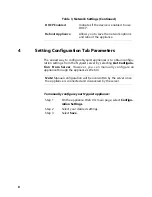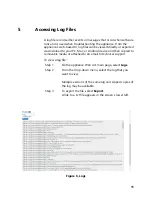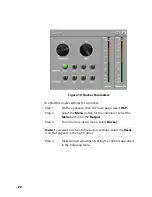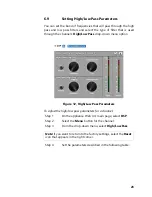
14
analog circuits. With DSP, you can alter analog signals, such as audio
or video signals, that have been converted to a digital format.
The DSP page shows
Mute
and
Level
selections for four input chan-
nels and allows you to do the following:
• View
Signal
and
Clip
LEDs for each channel.
• Set the channel level for the six input and two output channels.
• Select if the input channels use
Line
or
Mic
Input Type, Mic Gain, and Phantom Power” on page 17.)
• Set
Mic Gain
for an input channel using
Mic
as the input. (See
"Selecting Input Type, Mic Gain, and Phantom Power” on
page 17.)
• Control
Phantom Power
for any channel using Mic as the input.
Selecting the down arrow next to a channel number displays a menu
of other parameters. Some of these parameters affect all channels, in
which case a channel number does not appear on the top of the
graphic. If a parameter affects only the selected channel, a channel
number appears on the selected parameter graphic.
DSP parameters and the
Mute
and
Level
buttons are described in
the following table.
Table 6, DSP Page
Mute
Silences the audio for the selected channel.
Level
Adjusts the channel volume level in 1 dB
increments.
Compressor
Lessens the dynamic range between the
loudest and quietest parts of an audio signal.
Ducker
Lowers, or ducks, the output of a channel
when another signal is encountered.
Graphic EQ
Uses fixed frequencies to tailor the frequency
content of an audio signal.
Limiter
Prevents a signal from exceeding a certain
pre-set maximum level.
Noise Gate
Eliminates low-level hiss, noise, or leakage,
particularly when there is a high level of
ambient noise.
















































